Battle of Gettysburg

This illustration from Harpers Weekly of August 8, 1863. The caption stated "The Battle of Gettysburg - Longstreet's Attack on our Left Center - Blue Ridge in the Distance - From a Drawing by Mr. A. R. Waud.-
The Battle of Gettysburg took place around this small Pennsylvania town, when Confederate forces foraging for shoes encountered a Union cavalry brigade guarding the town. Both sides quickly brought their main units to bear. In the first day of the battle, Confederate troops forced Union forces back, but at a heavy cost. The second day, Confederates attacked heavily fortified Union positions, and were repulsed on every attempt. Finally, on the third day, Lee's forces attempted to attack the Union Center. The attack was called "Pickett's Charge". Less than half of the men involved in the charge returned. Gettysburg marked the last time the Confederates attempted to bring about a decisive battle on Union soil.
.
Despite his victory at Chancellorsville, Lee felt that time was not working in favor of the South. In a letter to Davis he wrote; "Our resources in men are constantly diminishing and the disproportion in this respect between us and our enemies, if they continue united in their effort to subjugate us, is steadily augmenting." Thus, Lee thought the time was auspicious to make a daring troop movement to the North to bring about a decisive battle. In early June, Lee began to disengage his forces from the lines on the Rappahannock, and move Northward. He headed up the Shenandoah valley, overran the Union garrison at Winchester, and moved behind the Blue Ridge mountains– which he used as a shield for his movements. It was not the Union forces who were in the dark, but rather Lee. General Lee had always counted on his cavalry, led by Jeb Stuart, to provide him with intelligence. Stuart, however, was out making a daring, but useless, raid around Union lines. He was totally cut off from Lee. As such, Lee was cut off from all intelligence. He had no idea that Union forces had crossed the Potomac in his pursuit. He also had no idea that President Lincoln had relieved Hooker and replaced him with Meade. When the messenger arrived at Meade's bed in the middle of the night, at first Meade thought he was being arrested. Instead, he was appointed Commander of the Army of the Potomac.
Meade moved his army North, always keeping them between himself and Lee’s positions. His orders were to protect Washington and Baltimore. His plans called for laying a defensive line behind the Pipe Creek Line. Lee soon learned about Meade's movements. His forces were scattered throughout Pennsylvania, with Ewells corps almost at Harrisburg. He sent out orders for all his forces to converge on Cashtown. Lee’s plans, and those of Meade, were soon changed by a little town called Gettysburg.
Word reached one of Lee’s commanders– Henry Heth, that there were shoes in the town of Gettysburg. He requested permission from AP Hill to take a division to Gettysburg to obtain the shoes. John Buford was ready to stop them, with two brigades of cavalry. The cavalry men were equipped with seven new shot Spencer carbines. The Confederates came down the Chambersburg Pike, led by the Alabama brigade, headed by James Archer. When they reached a rise in the road, they came under fire from Budford's cavalrymen. While Budford's cavalry were a force to be reckoned with, they would not be able to hold up against a complete Confederate corps that was heading their way. Fortunately for Budford, as he headed down from his observation post, Budford heard the calm voice of his commander John Reynolds. He asked: “What's the matter John?” The answer was: “The devils to Pay”. Reynolds rushed the first elements of his corps into position, opposite the oncoming Confederates. The Confederates headed up McPherson’s ridge. They were met by the concentrated musketry of the Iron Brigade. They were forced to beat a hasty retreat. John Reynolds, however, was killed by a sniper. Before long the Union lines were further strengthened, as additional troops arrived.
By the early afternoon, the main body of the Confederate forces had arrived. Lee reluctantly agreed to attack. The attack was successful, despite the heavy losses incurred. Union troops were forced to retreat from their lines. The first day of the Battle of Gettysburg was over. 8,000 Confederates and 9,000 Union men were casualties of this battle.
Fortunately for Meade's forces, the area to the South of Gettysburg was almost a perfect defensive position– a series of hill tops forming a U–shape. As day turned into night, more and more of the Union army arrived. By the next morning, the entire Army of the Potomac was in place. Lee's army was also in place. Longstreet recommended a flanking march around the Union lines, feeling the Union positions were too strong, Lee, however, wanted to attack the Union army, not flank it.
The attack commenced late in the afternoon, against the Union's flanks. The attacks took place, primarily, against Sickle’s corps, in a peach field and wheat field, below Cemetery Ridge. Sickle had moved his forces forward without permission, but it was too late to move them back from their exposed positions.
Longstreet's attacks on the peach orchard and the wheat field succeeded in slowly pushing back the Union forces. The cost was very high, and ultimately irrelevant, for the Union forces fell back up to Cemetery Ridge. The Confederate attempt to turn the Union flank, by capturing Little Round Top, also failed. Little Round Top was initially unoccupied. Longstreet expected to occupy it at no cost. However, at the last moment, the Union's Chief of Engineers also discovered that this strategic location was unoccupied and had the 5th corps send the 20th Maine to defend it. Colonel Joshua Chamberlain, who commanded the 20th Maine, went down in history as one of Gettysburg's heroes. Chamberlain was a Professor of Rhetoric and Modern Language at Bowdoin College. His outnumbered Maine soldiers held off repeated Confederate attacks.
Finally, when he felt his forces could not sustain another attack, Chamberlain ordered a fixed bayonet charge down the hill. The Confederates were so stunned they surrendered in mass, and Little Round Top remained in Union hands.
The Confederates nearly achieved a breakthrough in a gap near the center of line on Cemetery Ridge. General Winfield Scott Hancock was there and ordered reinforcements to plug the gap. They needed to slow down the oncoming Alabaman's for five minutes. 262 men of the 1st Minnesota were on hand. He asked them to charge the 1,600 Alabaman's coming up the hill. They did so. Sadly, only 47 returned. Though, they did give Hancock his five minutes, and he plugged the gap. Finally, Ewell’s Corp. made two attacks on Culp Hill and Cemetery Ridge. Both attacks achieved temporary successes, but were later repulsed. Day two of the battle of Gettysburg had ended. Both sides had suffered 9,000 casualties each.
Union generals met overnight. They voted to stay put and wait for another Confederate assault. Lee ordered Longstreet to attack the Union center, with Pickett's division and two of Hills divisions. Longstreet was reluctant, telling Lee: "General Lee, there never was a body of fifteen thousand men who could make that attack successfully." Lee told him that his men were ready and able. This attack was preceded by the largest Confederate artillery attack of the war. Confederate troops bombarded the Union positions for two hours. They had hoped to silence the Union artillery, and inflict serious damage to the line. However, most of their shots went long, and the Union's Chief of Artillery stopped returning the Confederates shots, in a ruse to convince them they had succeeded.
Finally, at 3 PM, Longstreet ordered the attack. It was over in an hour. The Union artillery opened up with devastating accuracy, and Union soldiers from entrenched positions poured devastating fire down on the Confederate soldiers. No amount of gallantry could compensate for the devastating firepower. Only half the fifteen thousand troops who began the attack returned.
When the battle was over, nearly 50,000 men were casualties, after three days of fighting.
| 20th Maine at Little Round Top | Lee's Account of the Battle |
| Day One From the Union | Day 3 From the Union |
| Longstreet Day 1 | Longstreet Day 2 |
| Longstreet Day 3 |

[Gettysburg, Pennsylvania. Officers of 50th Regiment Pennsylvania Infantry]. Gardner, Alexander, 1821-1882 photographer. Created-Published: July 1865.
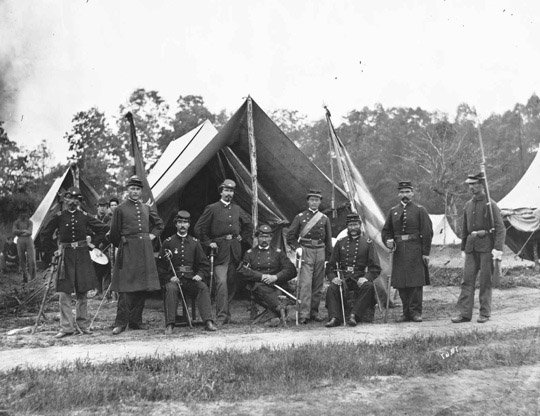
[Gettysburg, Pennsylvania. Field and staff officers, 69th Pennsylvania]. Smith, William Morris photographer. Created-Published: June 1865.
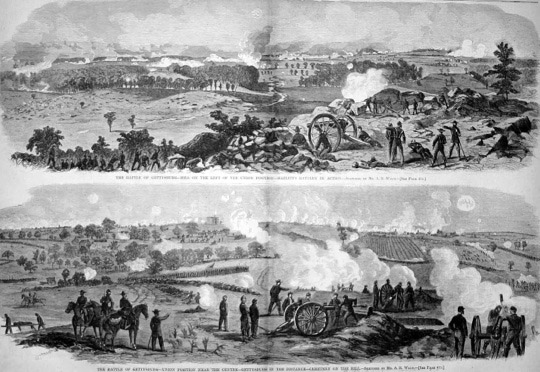
This illustration from Harpers Weekly of July 25, 1863. The caption stated "The Battle of Gettysburg - Hill on the Left of the Union Position - Hazlitt's Battery in Action - Sketched by Mr. A. R. Waud. The lower picture is captioned, "The Battle of Gettysburg - Union Position Near the Centre - Gettysburg in the Distance - Cemetery on the Hill.- Sketched by Mr. A. R. Waud

[Gettysburg, Pennsylvania. Big Round Top from entrenchments on Little Round Top]. Created-Published: 1863
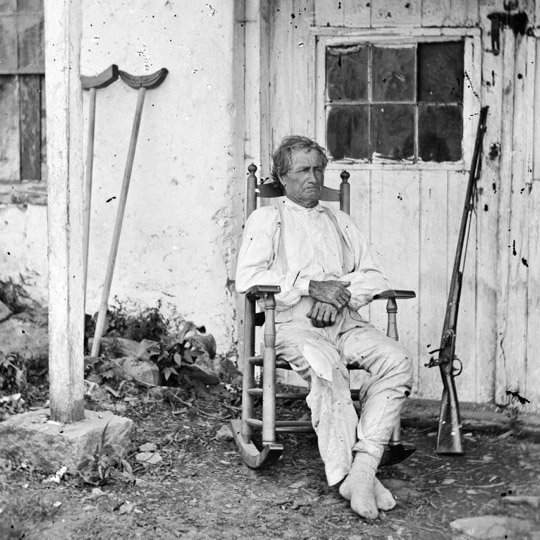
[Gettysburg, Pa. John L. Burns, the "old hero of Gettysburg," with gun and crutches]. O'Sullivan, Timothy H., 1840-1882 photographer. Created-Published: July 1863. Photograph from the main eastern theater of the war, Gettysburg, June-July, 1863.
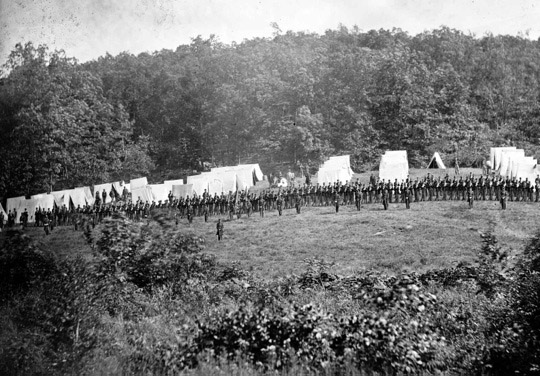
[Gettysburg, Pennsylvania. Camp of the 50th Pennsylvania Infantry]. Smith, William Morris photographer. Created-Published: July 1865.

[Gettysburg, Pennsylvania. Confederate soldiers as they fell near the center of the battlefield]. Gardner, Alexander, 1821-1882 photographer. Created-Published: July 1863.
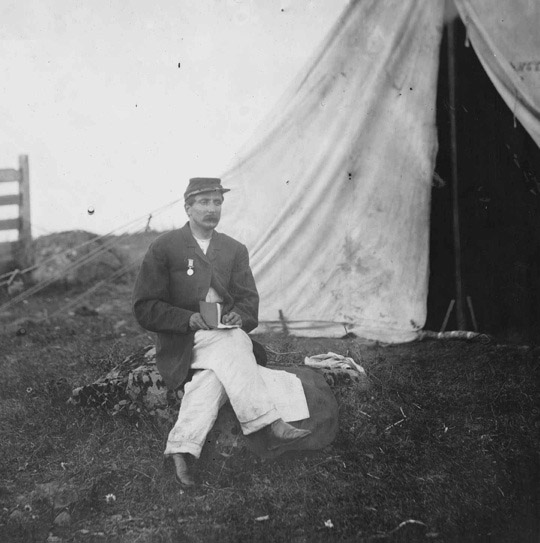
Gettysburg, Pennsylvania. Capt. John J. Huff's clerk]. Smith, William Morris photographer. Created-Published: July 1865

[Gettysburg, Pennsylvania. Camp of Captain John J. Hoff. Commissary of Subsistence]. Created-Published: July 5, 1865.
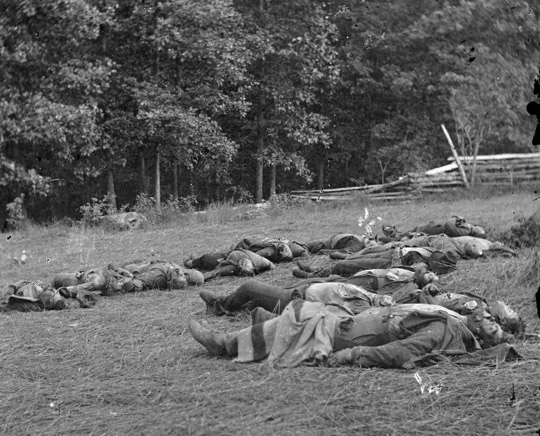
[Gettysburg, Pa. Confederate dead gathered for burial at the southwestern edge of the Rose woods, July 5, 1863]. O'Sullivan, Timothy H., 1840-1882 photographer. Created-Published: July 1863. Photograph from the main eastern theater of the war, Gettysburg, June-July, 1863.
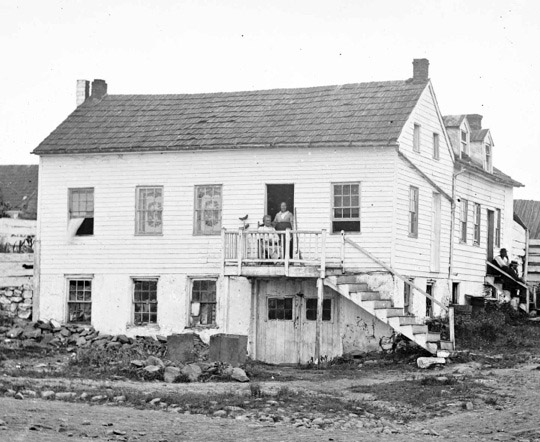
[Gettysburg, Pennsylvania. John L. Burns cottage. (Burns seated in doorway)]. O'Sullivan, Timothy H., 1840-1882 photographer. Created-Published: July 1863.

Pennsylvania. Adj. Lewis Crater 50th Pennsylvania Infantry]. Smith, William Morris photographer. Created-Published: July 1865.
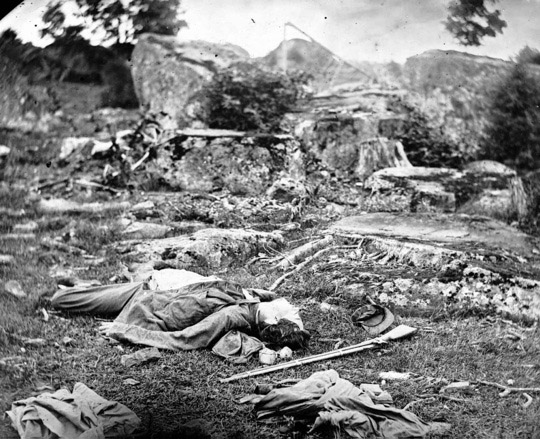
[Gettysburg, Pa. Dead Confederate soldier in Devil's Den]. Gardner, Alexander, 1821-1882 photographer. Created-Published: July 1863. Photograph from the main eastern theater of the war, Gettysburg, June-July, 1863
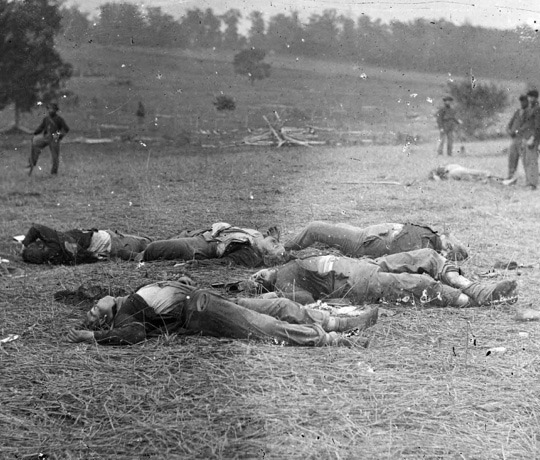
[Gettysburg, Pennsylvania. Federal dead on the right of the Federal lines, killed on July 1]. Gibson, James F., b. 1828 photographer. Created-Published: July 1863.

[Federal dead on the field of battle of first day, Gettysburg, Pennsylvania]. Created-Published: photographed 1863, printed later
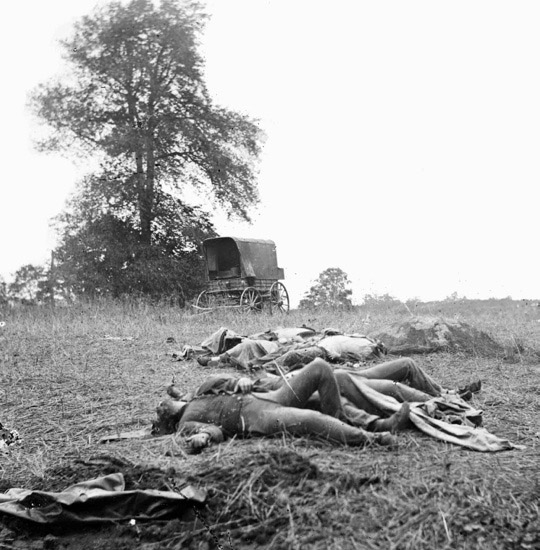
[Gettysburg, Pennsylvania. [Confederate dead gathered for burial, July 5, 1863]. Gardner, Alexander, 1821-1882 photographer. Created-Published: July 1863.
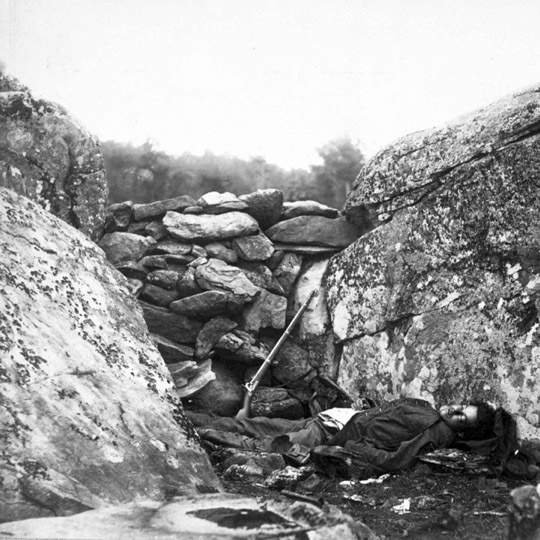
[Battle-field of Gettysburg--Dead Confederate sharpshooter at foot of Little Round Top [i.e., Devil's Den]]. O'Sullivan, Timothy H., 1840-1882 photographer. Created-Published: photographed 1863 July, printed later
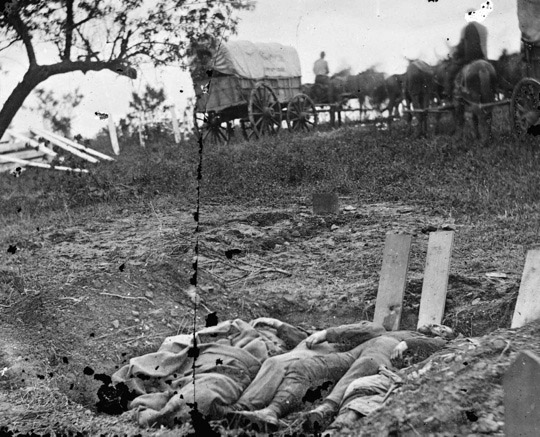
[Gettysburg, Pennsylvania. Unfinished Confederate graves near the center of the battlefield]. O'Sullivan, Timothy H., 1840-1882 photographer. Created-Published: July 1863.
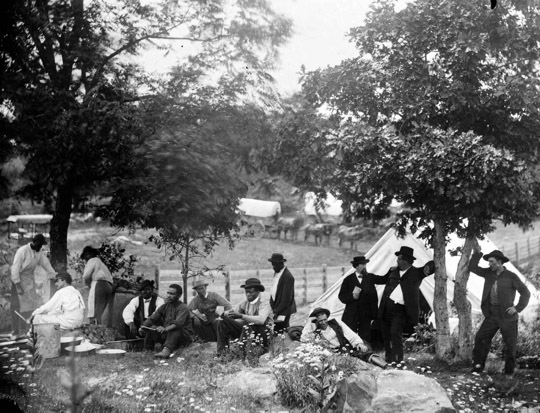
[Gettysburg, Pennsylvania. Camp of Captain John J. Hoff.Rear view]. Smith, William Morris photographer. Created-Published: July 1865.
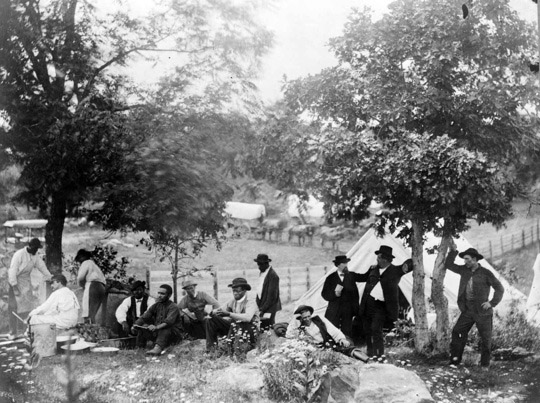
[Gettysburg camp of Captain Huft]. Gardner, Alexander, 1821-1882 photographer. Created-Published: July 1865 , printed later. Men gathered at Gettysburg, Pennsylvania, for the laying of the cornerstone of the Soldier's National Monument on the anniversary of the Battle of Gettysburg, men on left are preparing food.
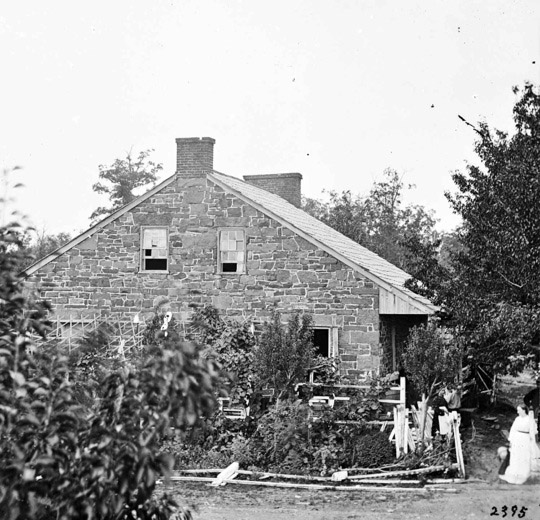
[Gettysburg, Pa. Headquarters of Gen. Robert E. Lee on the Chambersburg Pike]. Created-Published: July 1863. Photograph from the main eastern theater of the war, Gettysburg, June-July, 1863.

[Gettysburg, Pennsylvania. Little Round Top]. Created-Published: 1863.

[Gettysburg, Pa. Headquarters of Gen. George G. Meade on Cemetery Ridge]. Gardner, Alexander, 1821-1882 photographer. Created-Published: July 1863. Photograph from the main eastern theater of the war, Gettysburg, June-July, 1863.
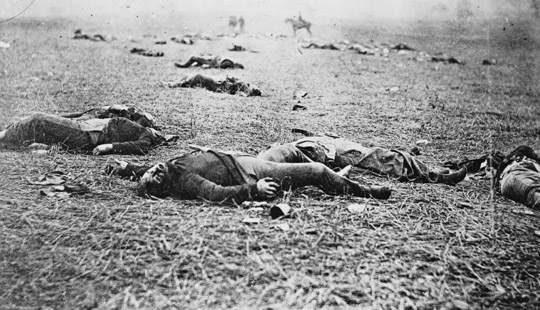
[Gettysburg, Pennsylvania. Bodies of dead on right of Federal line]. Created-Published: July 1863.
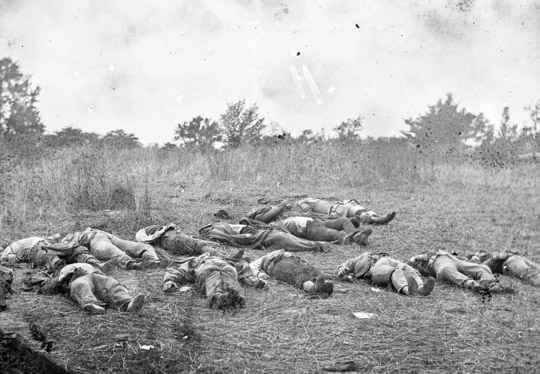
[Gettysburg, Pennsylvania. [Confederate dead, view looking toward the orchard on the Rose farm, July 5, 1863]. O'Sullivan, Timothy H., 1840-1882 photographer. Created-Published: July 1863.
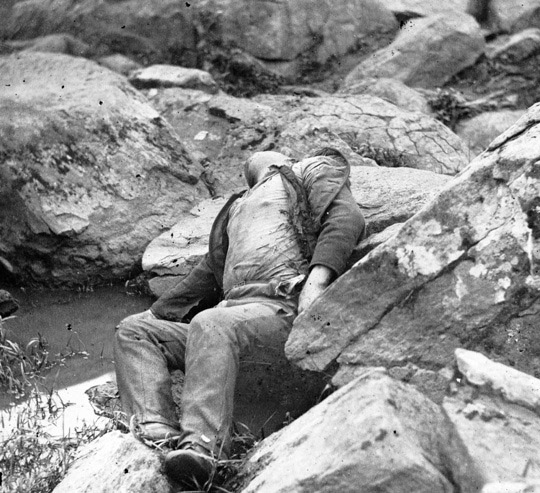
[Gettysburg, Pennsylvania. Dead Confederate sharpshooter at the foot of Round Top]. Gardner, Alexander, 1821-1882 photographer. Created-Published: July 1863.
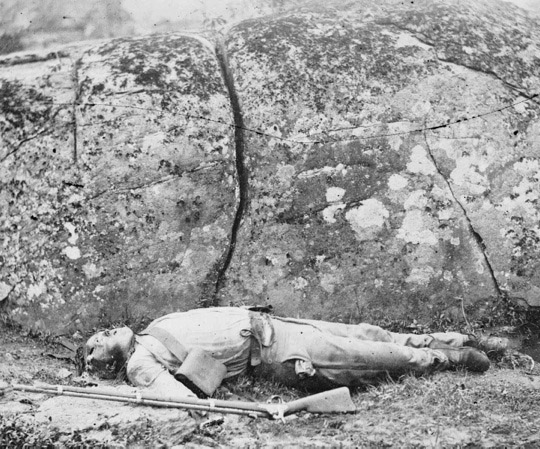
[Gettysburg, Pennsylvania. Confederate sharpshooter killed by a shell]. Gibson, James F., b. 1828 photographer. Created-Published: July 1863.

[Gettysburg, Pennsylvania. Confederate sharpshooter killed by a shell]. Gibson, James F., b. 1828 photographer. Created-Published: July 1863.
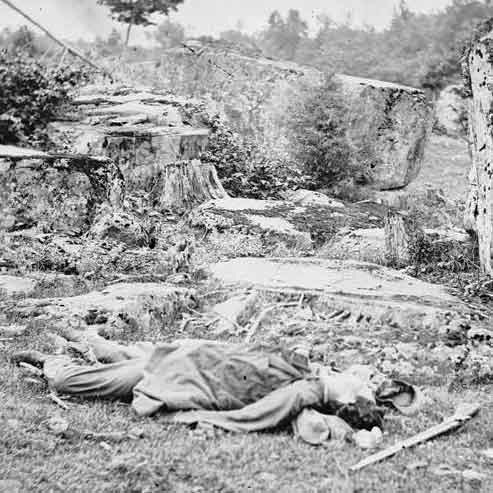
[Gettysburg, Pennsylvania. Dead Confederate sharpshooter]. O'Sullivan, Timothy H., 1840-1882 photographer. Created-Published: July 1863.
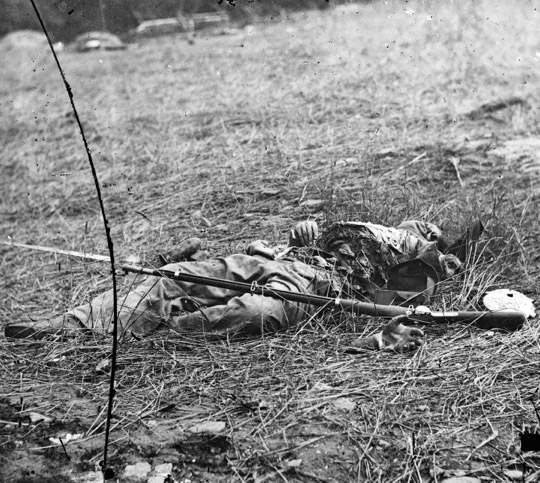
[Gettysburg, Pennsylvania. Effect of a shell on a Confederate]. Gardner, Alexander, 1821-1882 photographer. Created-Published: July 1863.
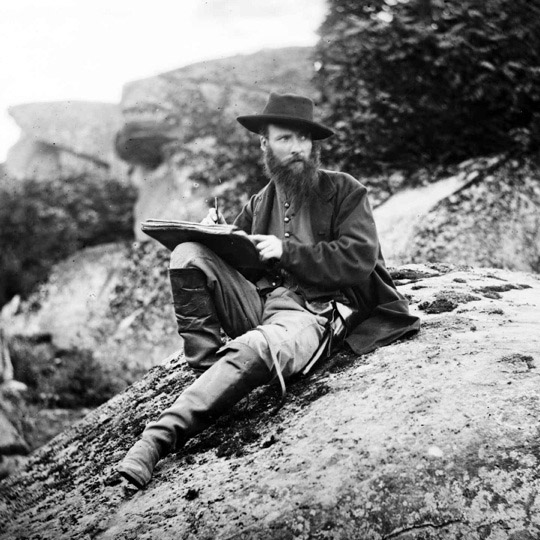
[Gettysburg, Pa. Alfred R. Waud, artist of Harper's Weekly, sketching on battlefield]. Created-Published: July 1863. Photograph from the main eastern theater of the war, Gettysburg, June-July, 1863.
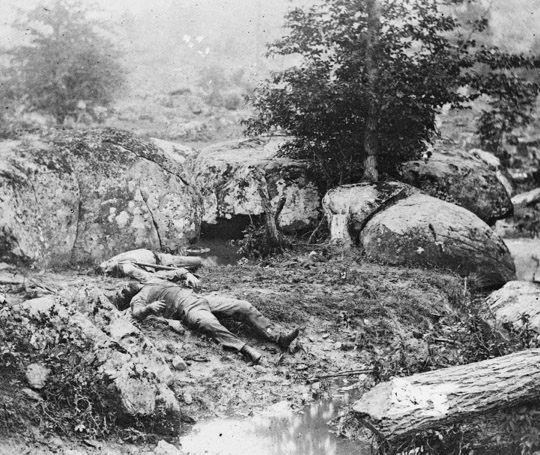
[Gettysburg, Pa. Dead Confederate soldiers in the "slaughter pen" at the foot of Little Round Top]. Gardner, Alexander, 1821-1882 photographer. Created-Published: July 1863. Photograph from the main eastern theater of the war, Gettysburg, June-July, 1863.
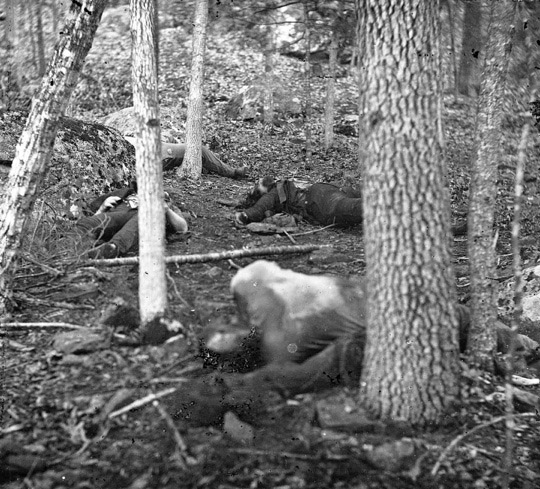
[Gettysburg, Pennsylvania. Slaughter pen at foot of Round Top]. Gardner, Alexander, 1821-1882 photographer. Created-Published: July 1863.

 >
>